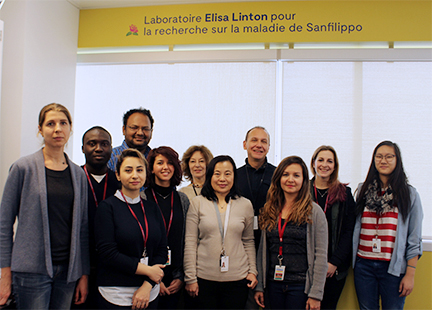
Research Axis
Metabolic and Cardiovascular Health Axis
Research Theme
Genetic and metabolic diseases in Quebec: diagnosis, mechanisms and interventions
Address
CHUSJ - Centre de Recherche
Fax
514 345-4766
Understanding and treating neurological genetic diseases
There are more than 7000 rare diseases, affecting 5 or less per 10,000 people. Most of these are genetic diseases, approximately half are affecting children. Because only less then 300 treatments have been approved for rare diseases in the last 30 years they remain one of the main burdens of health care system and our society in general.
Lysosomal storage disorders (LSDs) are genetic progressive metabolic conditions caused by accumulation (storage) of undegraded biological macromolecules due to defects in lysosomal catabolism. Most LSDs affect the central nervous system of children and many result in severe progressive neurodegenerative decline, behavioral problems, dementia and death before adulthood.
Some forms of LSDs are partially treatable by enzyme replacement therapy and hematopoietic cell transplantation. However, currently there is no effective treatment for neurological forms of LSDs caused by defects occurring in membrane proteins. The biggest challenge in developing therapies for neurological metabolic defects is achieving efficient delivery of the missing enzyme into the brain. We use Sanfilippo type C a neurological LSD caused by a deficiency in a transmembrane lysosomal enzyme as a template model. Our data will be broadly applicable for both neurological LSDs and neurological disorders caused by deficiencies of transmembrane proteins. We are the only laboratory in Canada dedicated to this problem.
Major achievements and current projects of our team:
- We discovered the genes responsible for lysosomal diseases; sialidosis and Sanfilippo C.
- We uncovered the pathogenic mechanisms of these diseases and provided methods for the molecular diagnostics currently used in clinical practice.
- We have defined the proteomes of the lysosomal membrane and matrix and have shown that impairment of the ubiquitin-dependent protein degradation pathway represents a common pathogenic mechanism in lysosomal storage diseases.
- We showed that the enzyme folding defects due to missense mutations constitute a major molecular mechanism of Sanfilippo C and that in most of cases the mutant enzyme can be rescued by treating patient’s cells with molecular chaperons, which suggested potential therapeutic approach for this disease.
- We developed mouse models of sialidosis and Sanfilippo C and showed that activation of brain macrophages (microglial cells) results in neuroinflammation and neuronal death. We are now correcting this pathology by engineering the overexpression of the deficient enzymes in microglial cells. This is done through transplantation of hematopoietic stem cells transduced with a recombinant lentivirus (LV)-based vector carrying the missing enzyme.
- We have shown clinical efficacy of the AAV delivery of the deficient enzyme into the brain of Sanfilippo C mice.
Biological role of sialylations and sialidases
Sialic acids are sugars found in abundance on the surface of mammalian cell, forming a dense array of sialylated glycoproteins and glycolipids. The majority of soluble, secreted and lysosomal proteins also contain sialic acids as part of their glycan chains. Sialic acids are involved in many biological processes mainly by modulating recognition events during cell differentiation, interaction, migration, and adhesion. Our work revealed that sialylation state of surface receptors regulates their biological activity. We have discovered that the enzyme neuraminidase 1 desialilates and changes activity of cellular membrane receptors including those responsible for inflammation response, phagocytosis, cell proliferation and glucose metabolism (insulin receptor). These studies established that the sialylation of receptors constitutes a novel mechanism controlling initiation of cellular signaling and suggested that neuraminidases can represent targets for therapy of human metabolic and immune diseases.
Major achievements and current projects of our team:
- We discovered that neuraminidases 1 and 3 trigger atherosclerosis by removing sialic acids from low density lipoproteins thus increasing their uptake by macrophages. We designed potent specific inhibitors of these enzymes and use them to block development of atherosclerosis in the mouse model.
- We found that neuraminidase 1 is specifically induced during inflammatory neonatal brain injury and that this induction changes sialylation of glycoproteins on brain cells. We now study how this affects neurodevelopment. .
- We found that insulin receptor is desialylated and activated by neuraminidase 1 and use pharmacological activation of this gene to restore insulin sensitivity and glucose homeostasis in obesity-induced diabetes model.
- We have discovered that excessive levels of blood neuraminidase 1 triggers immune thrombocytopenia, a disease of blood coagulation caused by low counts of platelets and currently test if specific inhibitors of this enzyme can treat the disease.
- We explore roles of neuraminidases 1, 3 and 4 in migration of immune cells during the sepsis.
Awards and Distinctions
- Champion of Genetics Award, Canadian Gene Cure Foundation, March 2013
- National Researcher, Fonds de recherche du Québec - Santé (FRQS), April 2002
- Award of Excellence in Paediatric Research, Foundation of Stars, November 2001
- Senior Researcher, Fonds de recherche du Québec - Santé (FRQS), April 1999
- Junior Researcher 2, Fonds de recherche du Québec - Santé (FRQS), June 1997
Research Team

From left to right: Team at the ceremony of Sanfilippo Research Laboratory Inauguration. Dr. Ekaterina Demina, PDF; Dr. Afitz Da Silva, PDF; Mahsa Taherzadeh, PhD student; MD Amran Howlader, visiting PhD student; Silvia Neri, MSc student; Dr. Pan Xuefang, Res. Associate; Dr. Alexey Pshezhetsky; Camila de Britto Para de Aragao, PhD student; Francesca Milani, MSc student; Annie Nguyen, Research. intern.
Publications
Full list on PubMed